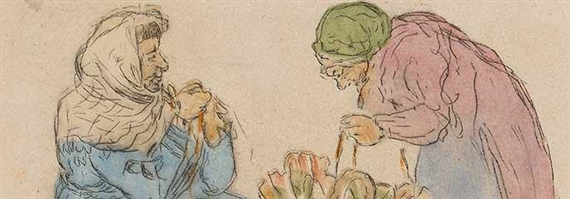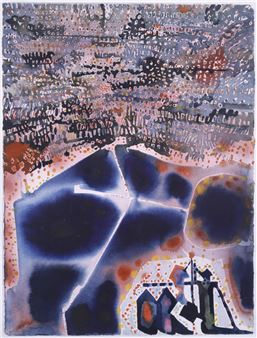Jerome Myers: Raising Hope in the New World
Jerome Myers: Raising Hope features a group of paintings and works on paper by the artist Jerome Myers, whose work spans the late 19th and first decades of the 20th century. MyersÔÇÖ work rightfully takes an esteemed place beside those other urban realists like Robert Henri, John Sloan, and George Luks, among many others, who confidently turned away from traditional studio themes to depict the familiar and everyday reality of their surroundings. Though their work was often met with derogatory criticism in their time, their intentions were inspired in part by the admonitions of Ralph Waldo Emerson to establish an American identity and Robert Henri, who evoked the ideal of ÔÇ£art for lifeÔÇÖs sakeÔÇØ in place of the aesthetesÔÇÖ ÔÇ£art for artÔÇÖs sakeÔÇØ.
Much of MyersÔÇÖ artwork focused on the children of immigrants, playing in the streets and in parks under the watchful eye of mothers and grandmothers who sit on stoops or park benches. Perhaps because of this, MyersÔÇÖ work has often been described as more romantic than the work of his colleagues who were more likely to depict the hustle and bustle of street life with descriptive images of the many characters they discovered selling their wares, drinking in bars, or enjoying a stage production. In MyersÔÇÖ work, we find similar subjects but almost always present are the immigrantsÔÇÖ children of the Lower East Side, their well-behaved presence and unsoiled clothing reflecting perhaps an old world style of parenting that was a little more strict and demanding. These children were part of the reason that families left their native country. The better life their parents sought was not only for themselves, but most importantly for the opportunities that America held for their sons and daughters. In the drawings, prints, and paintings featured in our exhibition, we will examine MyersÔÇÖ portrayal of these special youngsters as a fundamental theme and acknowledgment that they were not only essential to the promise for a better future for those who had recently arrived in the New World, but also to the artist as an ideal of imminent hope and bright prospects for his country.

Recommended for you
Jerome Myers: Raising Hope features a group of paintings and works on paper by the artist Jerome Myers, whose work spans the late 19th and first decades of the 20th century. MyersÔÇÖ work rightfully takes an esteemed place beside those other urban realists like Robert Henri, John Sloan, and George Luks, among many others, who confidently turned away from traditional studio themes to depict the familiar and everyday reality of their surroundings. Though their work was often met with derogatory criticism in their time, their intentions were inspired in part by the admonitions of Ralph Waldo Emerson to establish an American identity and Robert Henri, who evoked the ideal of ÔÇ£art for lifeÔÇÖs sakeÔÇØ in place of the aesthetesÔÇÖ ÔÇ£art for artÔÇÖs sakeÔÇØ.
Much of MyersÔÇÖ artwork focused on the children of immigrants, playing in the streets and in parks under the watchful eye of mothers and grandmothers who sit on stoops or park benches. Perhaps because of this, MyersÔÇÖ work has often been described as more romantic than the work of his colleagues who were more likely to depict the hustle and bustle of street life with descriptive images of the many characters they discovered selling their wares, drinking in bars, or enjoying a stage production. In MyersÔÇÖ work, we find similar subjects but almost always present are the immigrantsÔÇÖ children of the Lower East Side, their well-behaved presence and unsoiled clothing reflecting perhaps an old world style of parenting that was a little more strict and demanding. These children were part of the reason that families left their native country. The better life their parents sought was not only for themselves, but most importantly for the opportunities that America held for their sons and daughters. In the drawings, prints, and paintings featured in our exhibition, we will examine MyersÔÇÖ portrayal of these special youngsters as a fundamental theme and acknowledgment that they were not only essential to the promise for a better future for those who had recently arrived in the New World, but also to the artist as an ideal of imminent hope and bright prospects for his country.
Artists on show
Contact details


 ARTISTS
ARTISTS











